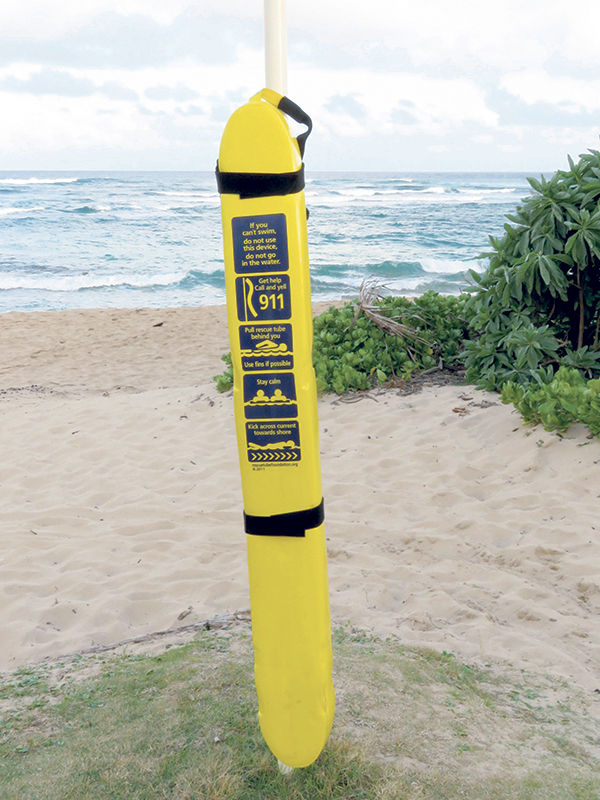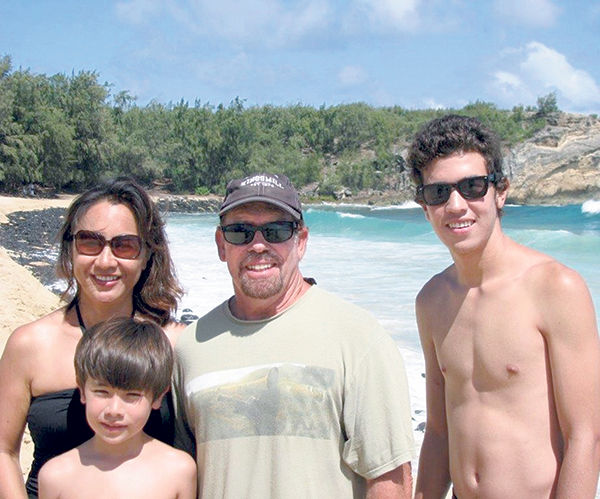When 16-year-old Taylor Garvey visited Kauai with his parents and younger brother last year, the last thing he expected was that he would have to rescue his father from drowning at one of Kauai’s beaches. Fortunately, Taylor knew exactly what
When 16-year-old Taylor Garvey visited Kauai with his parents and younger brother last year, the last thing he expected was that he would have to rescue his father from drowning at one of Kauai’s beaches.
Fortunately, Taylor knew exactly what to do when he realized his father was in trouble. By a stroke of luck – or was it fate? – Taylor had watched the water safety video that plays in the baggage claim area of Lihue Airport. Because the video plays non-stop, Taylor saw it more than a handful of times.
“I just watched it because it was there and to have that knowledge, just in case,” Taylor says. “I never thought in a million years that it would happen. I don’t think anybody ever thinks that it’s going to happen to them.”
It just sort of evolved
The family’s harrowing day took place at Kaakaaniu Beach, commonly known as Larsen’s, a beautiful, secluded and unlifeguarded beach on Kauai’s North Shore.
The Garvey family visits Kauai every three years, but they had never been to Larsen’s before, so Taylor’s father, Kevin, looked up the beach in a Kauai guidebook.
“We saw a sign at the beginning of the trailhead that said ‘Dangerous Swimming Conditions. 13 Drowning Deaths.’ But we didn’t really plan on doing a lot of swimming or snorkeling, so we thought this will be fine,” Kevin says.
“I have some beach experience having grown up in Southern California, visited the beaches a lot, bodysurfed, boogie boarded and surfed a little bit. I wasn’t unaware of the danger,” he says. “I had no intention of putting myself into a dumb tourist situation. It just sort of evolved.”
Kevin walked the length of the beach to get a sense of where it was safe to swim. The guidebook he was using advised to avoid the channel, which Kevin perceived as about two-thirds of the way down the beach.
“We were within the first one-third of the length of the beach, so I thought, ‘This is safe,’” he says.
Kevin started to snorkel in very shallow water, only three feet above the reef. When that began feeling a bit claustrophobic, he started to swim out a little deeper.
Suddenly a rush of current swept him out beyond the reef, into the open ocean. At first he was startled, but quickly calmed himself down and appreciated the larger fish that he saw in the deeper water. But within a few minutes, he decided he wanted to be in shallower water, where he felt safer.
He tried to swim back in but the current was much too strong.
“I’ve been in rip tides and heavy waves before, but I’ve never felt anything like that,” he says. “It was so strong that I would try to gain 15 feet then lose 20, gain 15 and lose 20.”
After struggling for about 15 or 20 minutes, Kevin had become exhausted. He was also having a hard time getting enough air through his snorkel. He took off his mask and snorkel to breath more easily, but in the choppy ocean, he began swallowing water.
I’m going to die
With fatigue setting in and realizing he couldn’t hold on much longer, Kevin began calling for help.
“Right at that moment, a wave picked me up and dumped me,” Kevin says. “It was so strong that it ripped off my fins. Without my fins, I’m without power and I’m feeling even more vulnerable. I was really exhausted by this time.”
Then the thought came:
“This is where I’m going to die. OK, there’s worse places to die. I’m going to die on Kauai. I wonder what it’s like to drown; that must be really scary,” Kevin said he thought to himself. “I thought, ‘This is what’s going to happen because I don’t really think I can get out of this.’ “
Just then he heard a sound: his son, Taylor’s voice.
“I hear, ‘Dad, hold on I’m coming!’ I thought, ‘Where did you come from?’ He was only about 10 or 15 feet away and I had not seen him coming toward me.”
Although Taylor normally snorkeled with his father, on this day he had chosen to stay onshore with his mother, Su, and younger brother, Torrey, 8. Taylor and Su had been keeping an eye on a lone male snorkeler in red swim trunks, assuming it was Kevin, who also was wearing red trunks that day.
When the man they had been watching got out of the water, they realized he wasn’t Kevin. Then Taylor began to panic because neither he nor Su had any idea where Kevin was.
Suddenly, Taylor saw Kevin standing up on the reef.
“I knew he was in trouble because my dad would never normally stand on the reef,” Taylor says. “Then I saw a wave crash on top of him. I knew I had to go out and help him.”
Dad needs help!
Taylor ran down the beach and grabbed a Rescue Tube, a four-foot long floatation device that is installed on many Kauai beaches for just such emergencies. He also grabbed a whistle that was hanging from the Rescue Tube pole, and stuffed it into his bathing suit pocket.
“My mom anxiously told me not to go in and for a second I listened,” Taylor says. “But then I yelled, ‘Dad needs help!’ I ran into the water yelling, ‘DAD!’ “
Taylor swam in the direction where he had last seen his father, though he couldn’t see him while because of the wave troughs.
“A wave finally elevated me enough to see my dad. He was face down in the water with his snorkel and mask on. I don’t think I will ever swim faster in my life,” Taylor says. “As I got to him, he kept groaning and yelling ‘Oh, God!’ I told him to grab onto the Rescue Tube and float on his back.”
Father and son waited for a rescue team to find them, Taylor holding his father’s head up as waves came, to help Kevin avoid swallowing more water. Taylor also blew the whistle every 20 seconds, “to assure my mom that we hadn’t drowned and to let people know where we were.”
As they floated, the current kept pushing them, but now it was pushing them toward shore – and toward the reef.
Then a large wave picked them up and smashed them onto the reef.
“I was thrown and tumbled underwater. I bounced on the reef and finally came up for air,” Taylor says. “The wave ripped my dad’s mask and snorkel off his face, and we lost each other because he let go of the floatation device.
“Just when we thought we were OK, another wave smashed us against the reef again. I knew this was not good for anyone’s health. I tried to pick up my dad around his waist, but he couldn’t walk,” Taylor says. “Finally, I told my dad to lie down and grab onto the Rescue Tube. I walked on the reef and pulled him back to shore.”
Taylor says he will never forget how selfless his father was once they got back onto the sand.
“I asked one of the nude sunbathers for some water for my dad and my dad saved half of it for me. I couldn’t convince him to drink any more until I did,” Taylor says.
After spending a couple days in the hospital to make sure he didn’t drown from all the water in his lungs – something that doctors told him occasionally happens – Kevin was released and the family flew home to California.
Su is still in awe over her son’s quick thinking and composure that day and has shared their family’s story with relatives and friends. And with Kevin fully recovered, the Garveys are looking forward to returning to Kauai in several years.
•••
Watch the video Taylor saw at: www.kauaiwatersafety.com. Pamela Varma Brown is the publisher of “Kauai Stories” and the forthcoming “Kauai Stories 2.”




